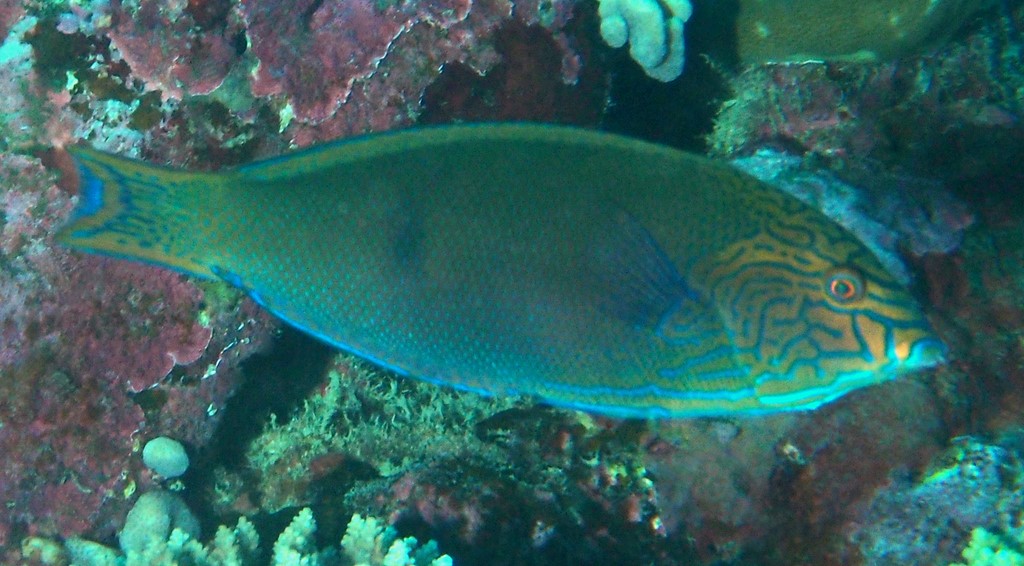ANAMPSES GEOGRAPHICUS - (VALENCIENNES, 1840)
Actinopterygii (Gigaclass) > Actinopteri (Class) > Teleostei (Subclass) > Labriformes (Order) > Labroidei (Suborder) > Labridae (Family) > Anampses (Genus)
Labre géographe, Labre géographique, Scribbled wrasse, Geographic wrasse, Olive-green wrasse, Scribbled chisel-toothed wrasse, Black-spotted tamarin, Brauner perljunker, Mushibera, ムシベラ, 虫纹阿南鱼, 蟲紋阿南魚,
Synonymes
Anampses lienardi (Bleeker, 1874)
Anampses pterophthalmus (Bleeker, 1857)
Anampsodax lienardi (Bleeker, 1874)
---------------------------
Description
Dorsal spines (total): 9; Dorsal soft rays (total): 11-13 (usually: 12); Anal spines: 3; Anal soft rays: 11-13 (usually: 12); Pectoral fin rays: 12-14 (usually: 13); Lateral line scales: 48-50 (to base of caudal fin; Usually one or two pored scales beyond); Gill rakers: 17-20; Depth of body: 2.7-3.1 in Standard Length; Width of body: 2.5-2.8 in Depth; Head length: 2.6-2.8 in Standard Length; Snout: 2.5-3.0 (juvenile) in Head Length; Eye: 1.5 (44-mm juvenile) to 3 in Snout ; Dorsal spines pungent; Caudal fin emarginate (more deeply emarginate in "geographicus" form), rounded in juveniles; Pectoral fins 1.75-2.1 in Head Length; Pelvic fins: 2.15 (male in " geographicus" color) to 2.7 (juvenile) in Head Length. Max. length: 31.0 cm TL. Depth range: 1 - 25 m.
Color
Female Inital Phase: brown and yellow-brown posteriorly; One large yellow-edged black spot on posterior of Dorsal and Anal fins; Pectorals yellow.
Male Terminal Phase: brown with narrow irregular blue lines on head; Blue submarginal line on Dorsal and Anal; Blue hind-margin on Tail and blue spots and fine lines on body scales and fins.
Etymology
Anampses: from Greek verb, anakampto = to reflect, bend back. Hence, to bend back one's course, return. Refer to the peculiar shape of the four anterior teeth.
geographicus: from Latin, geographic. Referring to numerous reticulations on head, like the lines or markings on a geographic map.
Original description: Anampses geographicus Valenciennes, 1840 - Type locality: no locality stated (Indian Ocean).
Distribution
Indo-West Pacific: Mauritius (Mascarenes) east to Caroline Islands (Micronesia), Fiji and Tonga, north to southern Japan, south to Rottnest Island (Western Australia), New South Wales (Australia), Lord Howe Island and New Caledonia and to Fiji and Caroline Islands.
Biology
Adults inhabit shallow coral reefs, often in weedy areas. Feed on benthic invertebrates. Expatriate juveniles are transported by currents to subtropical zones during pelagic stages. Pelagic spawner, Oviparous, distinct pairing during breeding. Occasionally seen in fish markets or aquarium trade.
Last update: 30, March 2023
Labre géographe, Labre géographique, Scribbled wrasse, Geographic wrasse, Olive-green wrasse, Scribbled chisel-toothed wrasse, Black-spotted tamarin, Brauner perljunker, Mushibera, ムシベラ, 虫纹阿南鱼, 蟲紋阿南魚,
Synonymes
Anampses lienardi (Bleeker, 1874)
Anampses pterophthalmus (Bleeker, 1857)
Anampsodax lienardi (Bleeker, 1874)
---------------------------
Description
Dorsal spines (total): 9; Dorsal soft rays (total): 11-13 (usually: 12); Anal spines: 3; Anal soft rays: 11-13 (usually: 12); Pectoral fin rays: 12-14 (usually: 13); Lateral line scales: 48-50 (to base of caudal fin; Usually one or two pored scales beyond); Gill rakers: 17-20; Depth of body: 2.7-3.1 in Standard Length; Width of body: 2.5-2.8 in Depth; Head length: 2.6-2.8 in Standard Length; Snout: 2.5-3.0 (juvenile) in Head Length; Eye: 1.5 (44-mm juvenile) to 3 in Snout ; Dorsal spines pungent; Caudal fin emarginate (more deeply emarginate in "geographicus" form), rounded in juveniles; Pectoral fins 1.75-2.1 in Head Length; Pelvic fins: 2.15 (male in " geographicus" color) to 2.7 (juvenile) in Head Length. Max. length: 31.0 cm TL. Depth range: 1 - 25 m.
Color
Female Inital Phase: brown and yellow-brown posteriorly; One large yellow-edged black spot on posterior of Dorsal and Anal fins; Pectorals yellow.
Male Terminal Phase: brown with narrow irregular blue lines on head; Blue submarginal line on Dorsal and Anal; Blue hind-margin on Tail and blue spots and fine lines on body scales and fins.
Etymology
Anampses: from Greek verb, anakampto = to reflect, bend back. Hence, to bend back one's course, return. Refer to the peculiar shape of the four anterior teeth.
geographicus: from Latin, geographic. Referring to numerous reticulations on head, like the lines or markings on a geographic map.
Original description: Anampses geographicus Valenciennes, 1840 - Type locality: no locality stated (Indian Ocean).
Distribution
Indo-West Pacific: Mauritius (Mascarenes) east to Caroline Islands (Micronesia), Fiji and Tonga, north to southern Japan, south to Rottnest Island (Western Australia), New South Wales (Australia), Lord Howe Island and New Caledonia and to Fiji and Caroline Islands.
Biology
Adults inhabit shallow coral reefs, often in weedy areas. Feed on benthic invertebrates. Expatriate juveniles are transported by currents to subtropical zones during pelagic stages. Pelagic spawner, Oviparous, distinct pairing during breeding. Occasionally seen in fish markets or aquarium trade.
Last update: 30, March 2023
